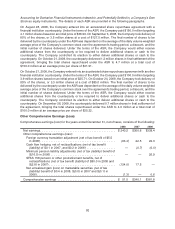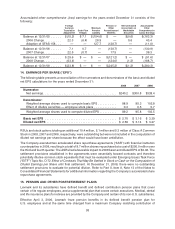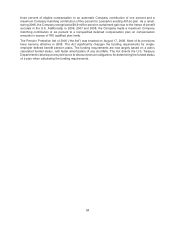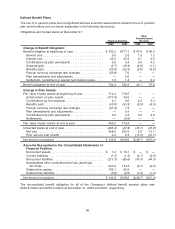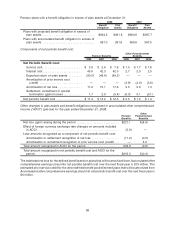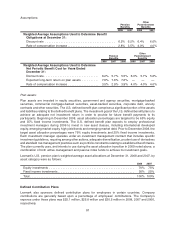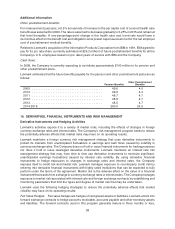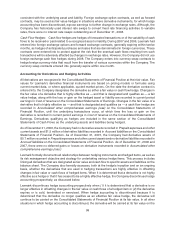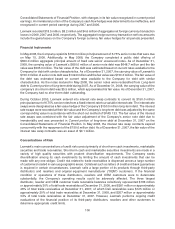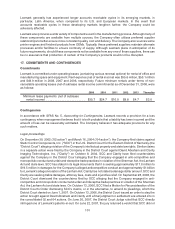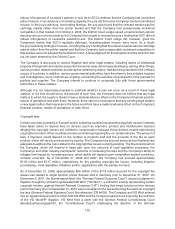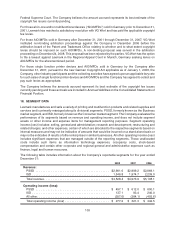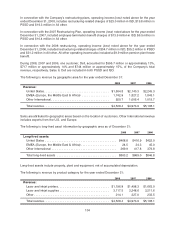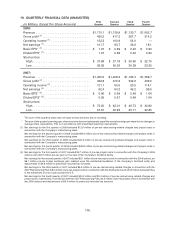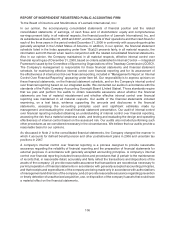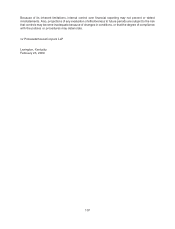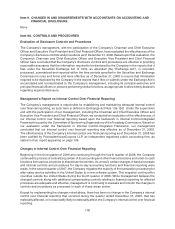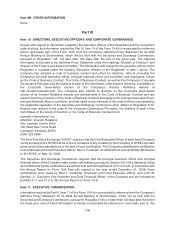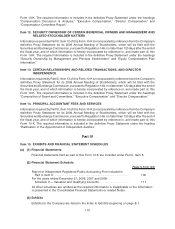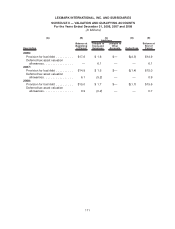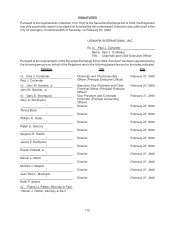Lexmark 2008 Annual Report Download - page 108
Download and view the complete annual report
Please find page 108 of the 2008 Lexmark annual report below. You can navigate through the pages in the report by either clicking on the pages listed below, or by using the keyword search tool below to find specific information within the annual report.induce infringement of Lexmark’s patents-in-suit. As to SCC’s defense that the Company has committed
patent misuse, in an advisory, non-binding capacity, the jury did find some Company conduct constituted
misuse. In the jury’s advisory, non-binding findings, the jury also found that the relevant market was the
cartridge market rather than the printer market and that the Company had unreasonably restrained
competition in that market. On October 3, 2008, the District Court Judge issued a memorandum opinion
denying various motions made by the Company that sought to reverse the jury’s finding that SCC did not
induce infringement of Lexmark’s patents-in-suit. The District Court Judge did, however, grant the
Company’s motion that SCC’s equitable defenses, including patent misuse, were moot. As a result,
the jury’s advisory findings on misuse, including the jury’s finding that the relevant market was the cartridge
market rather than the printer market and that the Company had unreasonably restrained competition in
that market, were not adopted by the District Court. A final judgment for the 02 action and the 04 action has
not yet been entered by the District Court.
The Company is also party to various litigation and other legal matters, including claims of intellectual
property infringement and various purported consumer class action lawsuits alleging, among other things,
various product defects and false and deceptive advertising claims, that are being handled in the ordinary
course of business. In addition, various governmental authorities have from time to time initiated inquiries
and investigations, some of which are ongoing, concerning the activities of participants in the markets for
printers and supplies. The Company intends to continue to cooperate fully with those governmental
authorities in these matters.
Although it is not reasonably possible to estimate whether a loss will occur as a result of these legal
matters, or if a loss should occur, the amount of such loss, the Company does not believe that any legal
matters to which it is a party is likely to have a material adverse effect on the Company’s financial position,
results of operations and cash flows. However, there can be no assurance that any pending legal matters
or any legal matters that may arise in the future would not have a material adverse effect on the Company’s
financial position, results of operations or cash flows.
Copyright fees
Certain countries (primarily in Europe) and/or collecting societies representing copyright owners’ interests
have taken action to impose fees on devices (such as scanners, printers and multifunction devices)
alleging the copyright owners are entitled to compensation because these devices enable reproducing
copyrighted content. Other countries are also considering imposing fees on certain devices. The amount of
fees, if imposed, would depend on the number of products sold and the amounts of the fee on each
product, which will vary by product and by country. The Company has accrued amounts that it believes are
adequate to address the risks related to the copyright fee issues currently pending. The financial impact on
the Company, which will depend in large part upon the outcome of local legislative processes, the
Company’s and other industry participants’ outcome in contesting the fees and the Company’s ability to
mitigate that impact by increasing prices, which ability will depend upon competitive market conditions,
remains uncertain. As of December 31, 2008 and 2007, the Company has accrued approximately
$118 million and $117 million, respectively, for the pending copyright fee issues, including litigation
proceedings, local legislative initiatives and/or negotiations with the parties involved.
As of December 31, 2008, approximately $56 million of the $118 million accrued for the copyright fee
issues was related to single function printer devices sold in Germany prior to December 31, 2007. On
December 6, 2007, the Bundesgerichtshof (the “German Federal Supreme Court”) issued a judgment in
litigation brought by VerwertungsGesellschaft Wort (“VG Wort”), a collection society representing certain
copyright holders, against Hewlett-Packard Company (“HP”), finding that single function printer devices
sold in Germany prior to December 31, 2007 were not subject to the law authorizing the German copyright
fee levy (German Federal Supreme Court, file reference I ZR 94/05). The Company and VG Wort entered
into an agreement pursuant to which both VG Wort and the Company agreed to be bound by the outcome
of the VG Wort/HP litigation. VG Wort filed a claim with the German Federal Constitutional Court
(Bundesverfassungsgericht, the “Constitutional Court”) challenging the decision of the German
102


